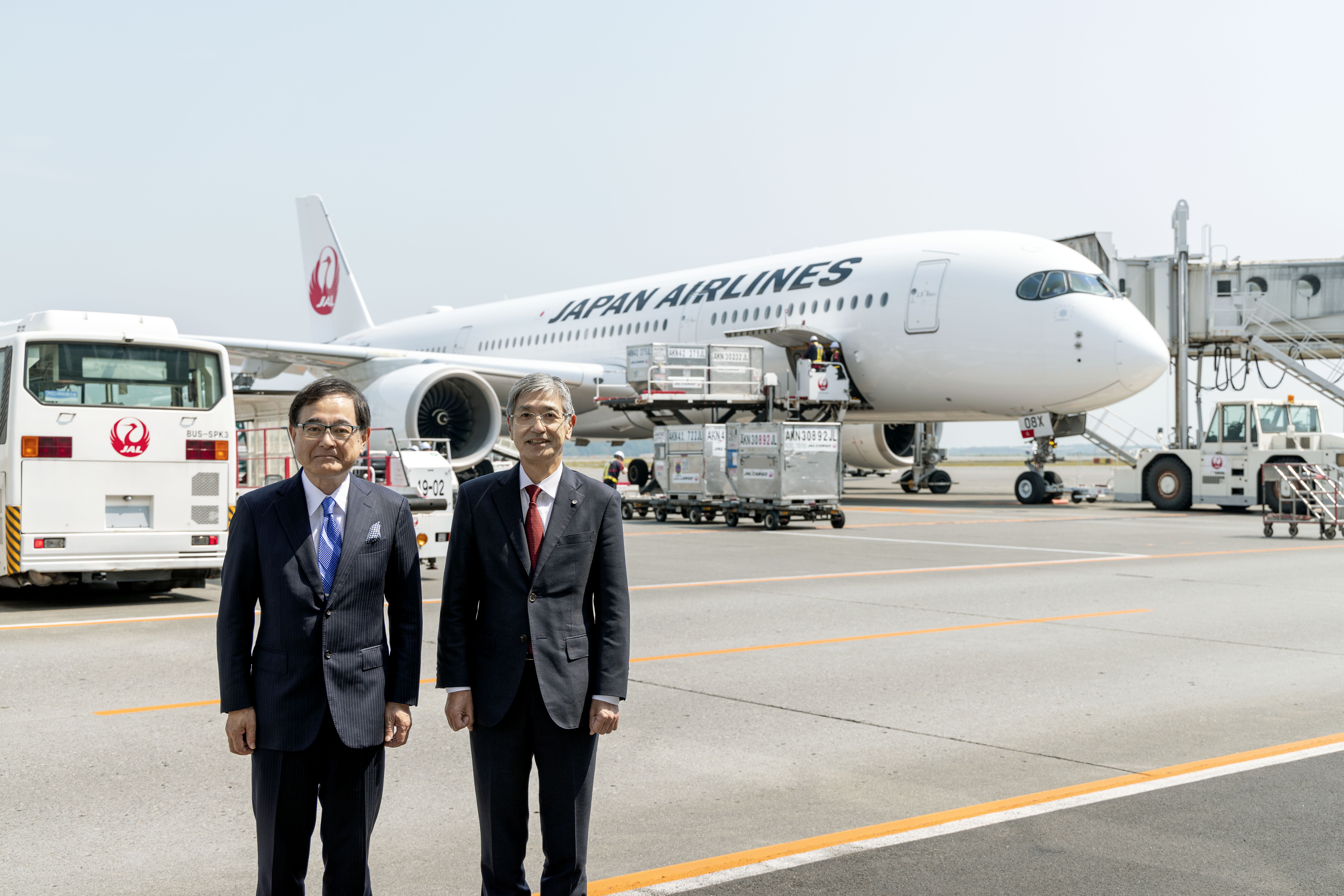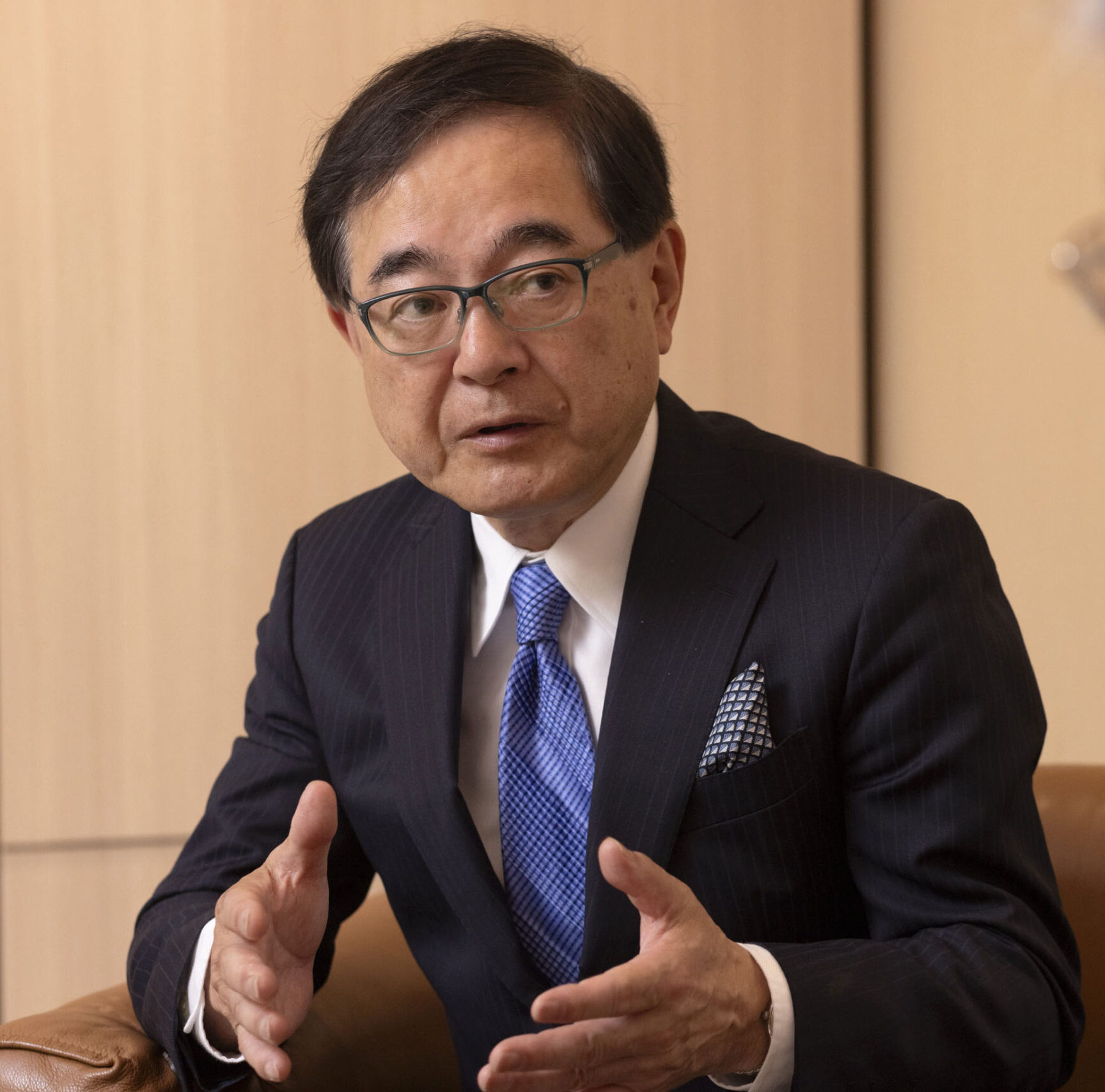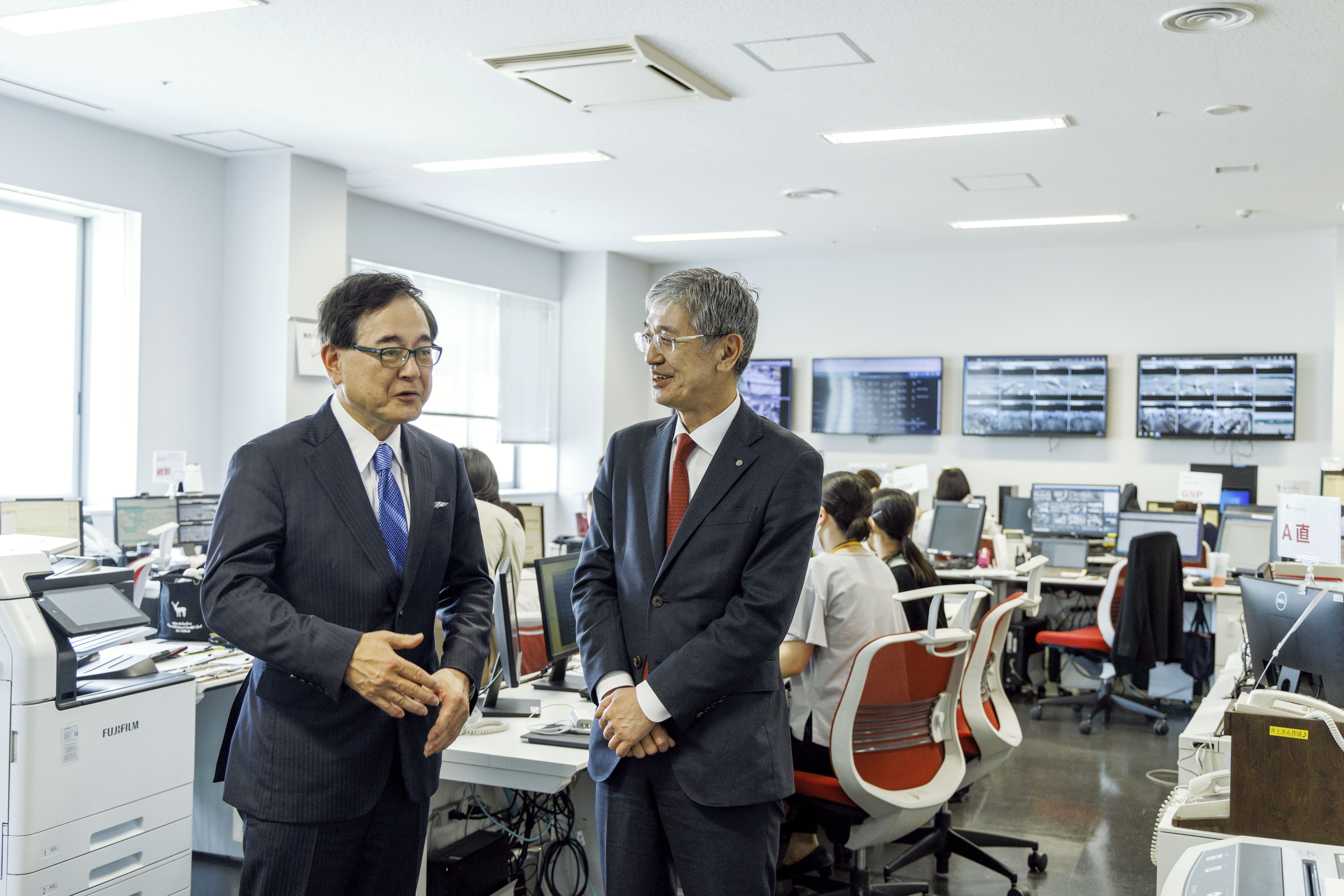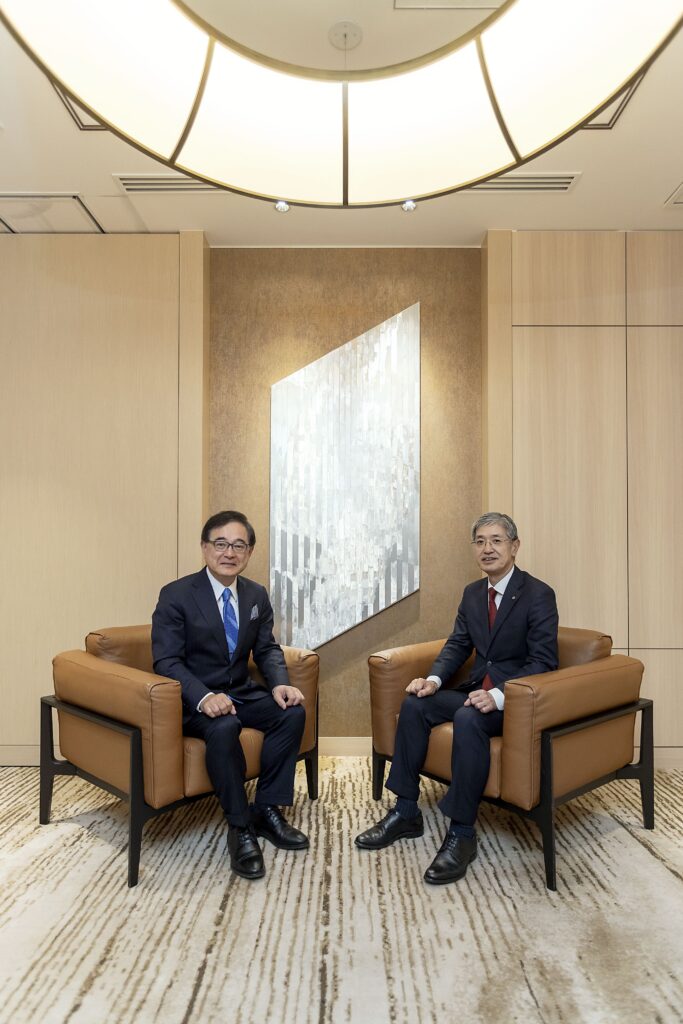Creating new value through collaboration between the airline industry and academia
University News | April 23, 2025
This article was published in the Autumn 2024 issue of Litterae Populi. The full issue can be found here.
Japan Airlines Co., Ltd. (JAL), a leading Japanese airline, signed a collaboration agreement with Hokkaido University in 2022. The current chairperson, Yuji Akasaka, is a specialist who has been at the forefront of the engineering and maintenance division since joining the company, ensuring aircraft safety. During his tenure as representative director, he led the company through the pandemic and continues to work toward achieving carbon neutrality in the airline industry. President Kiyohiro Houkin, who is driving reforms to make Hokkaido University an unparalleled institution, interviewed Akasaka about the reasons behind his decision to pursue a career in the airline industry, his attachment to his birthplace of Hokkaido, and his vision for the future.
- Yuji Akasaka (Guest)
-
Representative Director, Chairperson / Chief Safety Officer, Japan Airlines Co., Ltd.
Born in Hokkaido in 1962. Earned a degree from the De-partment of Aeronautics in the Graduate School of Engi-neering, The University of Tokyo. Joined Japan Airlines Co., Ltd. in 1987. Built his career in the engineering and mainte-nance division and was appointed managing executive officer of the company and senior vice president of the Engineering & Maintenance Division in 2016, while also serving as rep-resentative director and president of JAL Engineering Co., Ltd. Advanced to representative director and president of Japan Airlines in 2018, and served as representative director and president of Japan Airlines and chief executive officer of the JAL Group from 2023. Has been representative director and chairperson of the company since 2024.
- Kiyohiro Houkin (Interviewer)
-
President, Hokkaido University
Born in Hokkaido in 1954. Graduated from Hokkaido University School of Medicine. Doctor (medicine) (Hokkaido University). Worked for Hokkaido University Hospital and other facilities since 1979. After working as a visiting researcher at the University of California, Davis, became an assistant professor at the Hokkaido University Graduate School of Medicine in 2000, professor of Sapporo Medical University School of Medicine in 2001 and professor of the Hokkaido University Graduate School of Medicine in 2010. After becoming the director of Hokkaido University Hospital and vice executive president of Hokkaido University in 2013, and the director of Hokkaido University Hospital and vice president of Hokkaido University in 2017, assumed the present position in October 2020.
From designing to operating airplanes
Houkin: You lived in Sapporo until high school. Did you have any experiences during childhood that eventually led to your current career?
Akasaka: As a child, I played baseball in the summer and went skiing in the winter. If anything was even slightly connected to my current career, it would probably be the ski jumping I used to do at the Araiyama Ski Jump Ground.
Houkin: That’s exactly related to “flying.”
Akasaka: I majored in aeronautics at university, and my graduation thesis was on ski jumping. I was into model airplanes (U-Control) as a hobby, and I started thinking about designing airplanes for a living when I was a second-year high school student. When I looked into where I could study aeronautics, I was disappointed to find that Hokkaido University didn’t offer such a program, which was quite a shock.
Houkin: That’s why you went on to study at the Faculty of Engineering at The University of Tokyo. When you started job hunting, were you aiming for Japan Airlines (JAL) from the beginning?
Akasaka: No, not at all. My research was in design, specifically in aerodynamics, so I was actually considering heavy manufacturers or similar industries. Many other students in my lab were aiming for positions at automotive companies.
Houkin: Come to think of it, JAL isn’t a company that makes airplanes. Akasaka: I had almost settled on the heavy manufacturing sector, but in August 1985, the JAL Flight 123 crash on Mt. Osutaka occurred. That incident made me decide to join JAL because I felt that something needed to change in the airline industry.
Houkin: I would think that such an accident might lead people to develop negative feelings toward JAL and avoid choosing the company. What were your thoughts at that time?
Akasaka: I saw the accident as a serious problem for the entire airline industry. Although my studies focused on designing airplanes, I realized that unless those operating airplanes did their part properly, the demand for airplanes itself could plummet. I also thought that I might be able to help make airplanes safer and more beneficial to society by joining the operational side. In that sense, my decision to enter this industry was quite coincidental.
Houkin: Given that perspective, it seems almost inevitable to me that you ended up in the engineering and maintenance division. Could you tell me how your career progressed from there?
Akasaka: I started by replacing faulty airplane parts on-site, then moved on to planning how maintenance should be structured, and eventually to quality control. The longest phase of my career was in what is known as “reliability management,” where I was responsible for studying how many flight hours should elapse before parts are replaced, as well as developing systems to minimize human error.
Houkin: Safety is the foundation of the airline industry, so you were truly at the front lines. Airplane mechanisms are highly complex, and even the smallest maintenance oversight can lead to accidents. I imagine it’s an incredibly high-pressure job.
Akasaka: That’s true, but recently, airplanes have gained the ability to detect malfunctions on their own. This is part of a field known as “predictive maintenance,” which has undergone dramatic changes with the introduction of AI. That said, the experience and intuition of seasoned technicians remain indispensable.
Carbon-neutral initiatives
Houkin: In the medical field where I come from, we’ve struggled to extricate ourselves from a hierarchical structure dominated by doctors. In the airline industry, I get the sense that pilots are often seen as being at the top. Is it uncommon in the industry for someone like you, who rose through the ranks in the engineering and maintenance division, to reach the top position of chairperson?
Akasaka: Airlines have traditionally been divided into management and operational divisions. In the past, corporate management was handled primarily by those on the management side, who focused on how to run the company. However, that divide is gradually disappearing. Because safety is the most critical element in airline management, there’s a growing need to incorporate the knowledge and values of safety held by the operational side into corporate management.
Houkin: You were president during the height of the pandemic, which was an extremely challenging time for the airline industry. Looking back now, how do you feel about that period?
Akasaka: There were times when we had almost no revenue, and honestly, it felt like I was holding my breath the entire time. But I knew the pandemic would eventually end, so we just had to endure until that point. I devoted myself to preserving our resources and assets so we could survive that difficult period.
Houkin: I haven’t faced a major crisis in university management. When situations become uncertain, people tend to feel unsettled. I imagine leading the company during such a time must have been incredibly challenging.
Akasaka: With planes grounded, there was no work to be done. Some employees told me they felt like they weren’t contributing to society. For the first time, we sent more than 2,000 employees on loan to other companies. Their valuable contributions in those roles showed them they were still making a difference, which I thought was great. Everyone did an excellent job.
Houkin: Human resources are the lifeline of any organization, aren’t they? While airlines were hit by the pandemic, they also faced the major challenge of achieving carbon neutrality. The goal of becoming carbon neutral by 2050 is indeed ambitious. We’re also increasingly aware of Scope 3 emissions, as the CO2 emissions generated by the flights we take are part of the airline’s overall carbon footprint. What are your thoughts on these challenges?
Akasaka: Achieving carbon neutrality is recognized as a major challenge. The airline industry accounts for 2% of global CO2 emissions. One-fiftieth of total emissions is a significant figure. Unless we immediately advance the production of sustainable aviation fuel (SAF), the commitment of Japan’s airlines will be called into question. Since achieving carbon neutrality requires efforts across numerous sectors, as president, I frequently consulted with people from various industries, including forestry and manufacturing.
Houkin: That’s very insightful. In the medical industry, producing materials for endoscopic equipment, for example, generates significant CO2 emissions. Whereas the airline industry accounts for 2% of global emissions, the medical industry accounts for 4%. Zero-carbon initiatives are also necessary in the medical industry, but when we consider patient safety, we can’t afford to cut corners. In that sense, the medical industry should strengthen the kind of approach JAL is taking while balancing safety and sustainability.
Akasaka: Absolutely, this is a challenge that’s common to all industries.
JAL’s collaboration with Hokkaido University and his attachment to Hokkaido
Houkin: Since JAL and Hokkaido University signed a collaboration agreement in June 2022, I’ve had valuable experiences, as we’ve worked together on various activities. For example, we’re grateful that data gathered from aircraft has been used for climate change research at our university. What are your thoughts on collaborating with academia?
Akasaka: I believe the most important thing is how we utilize data. For example, we attach cameras to planes operated by Hokkaido Air System Co., Ltd. (HAC), a subsidiary of JAL, to gather data on oceanic changes in Hokkaido’s waters. However, if we collaborate with a private company, there’s a possibility that the data might remain confined to that company. By having the university to handle the data in an open environment and to invite broader academic use, however, I think we can increase the value and broaden the scope of the initiative.
Houkin: Universities are well-suited for sharing data, so we’re very grateful that the data can be utilized in this way. I’d also like to hear your thoughts on community engagement. Even with the expansion of the bullet train network, air transportation remains essential in Hokkaido. How do you view the relationship between airlines and communities?
Akasaka: If people leave regional communities, the number of air travelers will decrease, so maintaining the regional economy and society is crucial for airlines. I believe Hokkaido University plays a significant role in addressing Hokkaido’s challenges, and if we can contribute in any way, it will be highly meaningful.
Houkin: For example, HAC is a lifeline for the region. It’s indispensable also for healthcare workers traveling throughout Hokkaido to support regional medical services.
Akasaka: For us, HAC serves as a way to raise an important question: How should Hokkaido’s transportation system be restructured for the future? With Hokkaido Railway Company scaling back its rail service, we need to rethink how people live in such a vast region like Hokkaido. I believe we need a collective effort to redesign the entire transportation landscape.
Houkin: With Rapidus Corporation planning to build a new plant in Chitose, the city is becoming increasingly connected with the aviation and semiconductor industries. I believe that over the next 10 to 20 years, New Chitose Airport could develop into an international hub. What’s your vision for the future relationship between Hokkaido and the aviation industry as new industries take shape?
Akasaka: We need to develop Hokkaido’s resources, such as energy, food, and tourism, into means of addressing societal challenges. In that context, we believe that infrastructure centered on aviation is crucial. Ideally, we’d like to expand international routes from New Chitose Airport; and if the airport alone isn’t sufficient, we aim to establish a global network centered on airports across Hokkaido.
Houkin: It’s still just a dream, but a realistic one, and I believe New Chitose Airport will be at the heart of it. Personally, I love airports—the thrill of watching people arrive and depart. It’s something that truly excites me. I must say, I’m a bit envious of your work. How do you feel about it?
Akasaka: Well, without that excitement, it might be hard to keep going (laughs). But I want to make the whole region exciting, not just airplanes. I believe Hokkaido holds a lot of potential.
Houkin: As Hokkaido is your birthplace, I hope you’ll continue to contribute to its future. Thank you very much for your time today.
This article was published in the Autumn 2024 issue of Litterae Populi. The full issue can be found here.





